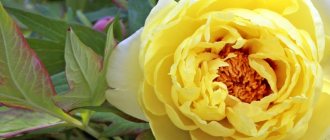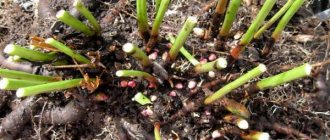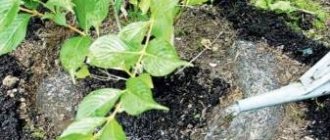Growing tree peony from seeds
Now let's look at how to properly plant tree peony seeds. Typically, professional flower growers are involved in breeding tree peonies from seeds, since this method is much more complicated. In addition, the plant will need 5-6 years for the seed to turn into a flowering bush, while seedlings, depending on their age, can bloom in the first or second year.
In addition, for tree peony seeds to germinate, they require mandatory stratification. In addition, with more or less long-term storage, the seeds completely lose their viability. Thus, growing tree peonies by sowing requires much more patience with no guaranteed results.
The fruits of this plant ripen in September - early October. You can tell that the seeds are ready for collection by looking at the slightly open seed pod. The most viable seeds are large (up to a centimeter in length) seeds that have a shiny, smooth, dark-colored surface. Sowing is carried out after three days of drying. Seeds are placed to a depth of 3 cm in loose, fertile soil until the first frost. It is better if the soil is moist. On the eve of winter, it is recommended to cover the sowing site.
Theoretically, some of the seeds can sprout in the spring, but in most cases, tree peony germinates only in the second or even third year. It is in order to guarantee high germination already in the first spring that it is recommended to subject the seeds to temperature stratification. For this purpose, in the fall, the seeds are buried not in open ground, but in a pot or box with soil. After the pot/box of seeds has overwintered outside, it should be taken indoors in March and kept at room temperature. By following these steps, you can guarantee a fairly high germination rate even in the first spring.
An alternative way to increase the germination of seeds is to collect them immature and place them in damp sand or peat for 10-12 weeks at room temperature. After this, the seeds should be placed in the refrigerator or basement so that they remain at a temperature of 5-8 degrees for about 3 months. In May, such seeds can be planted in open ground at a depth of up to 5 cm. The seedlings should hatch before autumn and will grow very slowly. They should be watered very sparingly, and 3-4 weeks after planting they can be fed with liquid fertilizers. The soil around the shoots is mulched, and for the winter the plants need to be thoroughly covered with peat or dry leaves. You can learn more about how to properly plant a tree peony in the spring from a special video.
How to propagate a tree peony by grafting
As a rule, propagation by grafting is used if other methods (dividing the bush, cuttings or obtaining layering) have failed. Tree peony is grafted onto shoots of any herbaceous variety. It is better to reproduce in late May - early June.
Many gardeners believe that propagating tree peonies by grafting is a very complicated process, although in fact the procedure is not difficult. The procedure is carried out as follows:
- Take the top shoot from the peony (not the peduncle, but an ordinary branch) and make a cut so that 3-4 buds remain. It must be done at an acute angle so that the surface area is large enough. It is advisable to do it in one sharp movement. The result will be a scion - a branch that will be grafted onto an adult bush (rootstock) for further growth. Cut shoots can be placed on a clean cloth or in a bag.
- It is necessary to treat the rootstock - this is the middle part of the stem with one leaf and a well-developed bud. A straight cut is made, and then a cleft is made, the parameters of which are adjusted to the scion.
- The next step is to insert the scion into the crevice of the rootstock.
- The structure must be secured with grafting tape, which can be purchased at a specialized store.
- The next stage of tree peony propagation is immersing the rootstock in a solution of “Epin”, “Kornevin” or another root growth stimulator for several hours. Then rooting is carried out in fertile soil (you can choose any container).
- Water generously, and if excess moisture remains, remove it with a cloth or napkin. Cover with a dark cap and keep at room temperature until the scion fuses with the rootstock.
- The last stage of propagation is transplanting the tree peony to a permanent place. This must be done exactly in a year. During this time, the cuttings are grown at home as a regular houseplant.
Important! You cannot handle the sections with your hands - it is necessary to maintain sterility
Further care of plants
Caring for a tree peony is simple; even a less experienced gardener can handle it:
- Watering. Rare, but plentiful - 6–10 liters of water per plant once every two weeks. In hot weather, the interval is reduced to 5–8 days. From the beginning of August, the norm is gradually reduced, and by October they stop watering the peony altogether. After each watering, the soil is loosened to a depth of 4–5 cm, the diameter of the tree trunk circle is 0.5 m. Renew the layer of mulch as necessary - it does not allow moisture to quickly evaporate and prevents weeds from growing.
- Feeding. 4 times per season is enough. Every time before fertilizing, abundant watering is required. At the beginning of the active growing season - 40–50 g of nitrogen fertilizer (urea, ammonium sulfate). During the formation of buds and about a week after the beginning of flowering - complex feeding for ornamental flowering plants. A month after flowering - 15–20 g of potassium and phosphorus fertilizers or a glass of wood ash and half the amount of dolomite flour.
- Trimming. It is carried out in the spring, before active growth begins. Please note that buds form on last year's shoots. All dried and dead stems are cut off, shoots older than 5 years are shortened to 15–20 cm. When the bush fades, the stems that had buds are cut to the upper axillary bud. Once every 20 years, rejuvenating pruning is recommended - all stems are cut off almost at soil level, leaving “stumps” 3–5 cm high.
- Shelter for the winter. The plant is afraid not so much of frost as of early thaws and subsequent cold weather. In October, the stems are tied, the trunk circle is cleared of plant debris and mulched with a layer of humus about 10 cm. On top, if dimensions allow, a bag is put on or a “hut” is built (a frame of poles covered with burlap or covering material). The bush under cover is covered with fallen leaves, spruce branches, pieces of bark, and shavings.
Planting care
Caring for tree peony plantings is not difficult.
- seedlings are regularly watered or moistened with a spray bottle so that the soil remains consistently moist;
- at the end of summer, superphosphate and potassium salt are added - this mixture will allow you to successfully survive the winter;
- cover with spruce branches, peat or improvised materials;
Attention! In early April (after the snow melts), the mulch is removed so that the cuttings of the tree peony do not rot. In the future, they are cared for in the same way as adult plants: regular watering is provided and fertilizers are applied at least 3 times per season: in spring (nitrogen), at the beginning and end of summer (superphosphates and potassium salt). For the winter, mulching is carried out (in the southern regions the procedure is optional).
Reproduction methods
There are several known methods of propagating shrubs. Gardeners mainly use vegetative methods:
- dividing the rhizome;
- cuttings;
- layering;
- vaccination.
Rhizome division and cuttings
Three or five year old plants with strong branches are suitable for this procedure. This event is held in late summer or early autumn. The bush is carefully dug up, cleared of soil and washed. The branches are all shortened, leaving 10-15 cm, and the workpiece is put in the shade so that the root system dries out. Then the plant is divided into several seedlings with 2-3 buds. The cut areas are treated with charcoal and fungicide. Next, the seedlings are planted in a permanent place in the garden plot.
Propagation of violets at home by leaves and stepsons
Cuttings are carried out during the summer season. To do this, gardeners choose a plant with slightly woody shoots and pronounced nodes. Cut blanks 10-15 cm long and with 2-3 buds, and the lower cut is made obliquely. The cuttings are planted in a container with fertile soil. Each seedling is covered with a cut plastic bottle. Strong cuttings can be planted in a greenhouse until next year. With this method, the plant begins to bloom only in the fifth year.
Reproduction by layering and grafting
Before flowering begins, in the spring, they begin propagation by layering. To do this, make an incision on a long branch, treat it with a root growth stimulator and press it to the ground. First dig a shallow trench. The cuttings are fixed with wire and sprinkled with a 15 cm layer of soil. When the cuttings take root, they are cut off and planted in a permanent place.
To propagate a plant by grafting, you need to put in a lot of effort. Why do gardeners rarely use this method? As a rootstock, blanks from the roots of herbaceous peonies 15 cm in length are used. As a scion, a cutting is prepared from a one-year-old shoot with two buds. A wedge-shaped cut is made on part of the root, and the bottom of the scion is sharpened so that it fits perfectly into the cut. Then they are connected, wrapped in polyethylene and coated with varnish. The joint is placed in a container with damp sawdust until it grows together.
Reproduction of tree peony by layering
To obtain layering from a tree peony, choose relatively young bushes aged 3-4 years or older. Reproduction begins in May (in the southern regions - at the end of April), and the process ends in early September.
Sequencing:
- Choose a powerful bush with developed lower shoots.
- One of the branches is carefully bent to the ground and secured with pins, wire or other available means.
- Sprinkle with soil. The branch should be under the soil layer.
- Water along the shoot.
In the future, there is no need to specially care for this branch, since it will receive the necessary nutrients from the mother bush. It is advisable to additionally water and mulch the soil so that it retains moisture longer.
By the beginning of September, the shoot will take root in several places, i.e. This method of propagating a tree peony guarantees the appearance of at least two layerings. They are carefully separated using a sharp knife, the cut points are sprinkled with charcoal, and then planted in a permanent or temporary area.
Full-fledged bushes from cuttings will grow in 3-4 years
Peonies after flowering
After flowering, the following procedures must be carried out.
Transfer
Transplantation is carried out in August-September. The plant tolerates this procedure painfully. Some branches dry out, but there is no need to panic about this. They are cut off, and in April young buds appear, producing new shoots.
Dry, diseased roots are removed from the dug plant. The sections are treated with activated carbon.
Trimming
In September, the upper shoots with seeds and peduncles are removed to the first bud.
The main pruning is carried out in March-April after the buds awaken. Dead, dried branches are cut off at the root. Strong ones - up to the first bud, and weak ones - up to 10 cm from the soil surface.
Preparing for winter
When the first frosts appear, the shortened shoots are carefully tied loosely with wire or twine and protected from snow drifts with spruce branches, burlap, and lutrasil.
Reliable shelter from the cold
Features of pruning tree peonies
Pruning must be carried out in the spring before the period of intensive growth begins. In this case, you need to cut off the dried stems. Old shoots must be trimmed so that about 10 centimeters remain. Flower growers in China have learned to rejuvenate tree peony. To do this, once every 20 years they cut the bush almost to the surface of the soil. As a result of this, adventitious buds awaken at the very base of the stems.
Pruning must be carried out in the spring before the period of intensive growth begins.
In order for flowering to be more abundant next year, you need to trim the stems to the upper axillary bud. How long your peony will live depends on the correct pruning. These plants can live to a very respectable age, as a rule, up to a hundred years or even more. In China, there are specimens that are already over 500 years old, and they are protected both by specialists and by law.
Rules for caring for tree peonies
Watering plants
Tree peony does not need frequent irrigation. You can water it 1-2 times a month depending on weather conditions. The amount of water per watering is approximately 6-7 liters. After irrigation, you should slightly loosen the soil near the bush, while simultaneously removing sprouted weeds. As a rule, tree peonies are watered in the first months of summer, and moisture is stopped in August.
Fertilizing flowers
The first three years of life the plant needs foliar feeding. To do this, 40 g of urea and mineral fertilizers are diluted in 10 liters of water, and then the bush is sprayed after watering.
Peonies over three years old are fertilized three times a year:
- The plant is fed for the first time in early spring, at a time when the bush produces young shoots. Nitrophoska is used as a fertilizer in the amount of 100 g per 1 bush.
- During the period of swelling of the buds, the time comes for the second feeding. It is also carried out with nitrophoska, the amount of fertilizer does not change.
- When the peonies fade, they can be fertilized a third time. For this purpose, use 30 g of superphosphate for each bush.
Bone meal, ash or humus is considered a good fertilizer for tree peonies. Acidic substances and nitrogen fertilizers are not recommended.
Tree peony, photo:
Sheltering peonies for the winter
Despite the fact that the tree peony is considered a frost-resistant crop, in particularly unfavorable climatic conditions the plant needs protection. Preparations for winter should begin in October. At the end of the month, the shoots of the plant are carefully tied up, and the soil near the trunk is mulched with spruce branches or peat. With the arrival of the first frost, the bush must be covered. For this, bags or spruce spruce branches are used.
With the onset of spring, when the buds swell on the shoots, the bushes are freed from shelter. Broken branches are removed, and healthy ones are shortened by one third. If these conditions are met, the flowers of the tree peony will be large and beautiful, and the plant itself will be strong and healthy.
Disease and pest control
This is not to say that tree peonies get sick too often, but they are still susceptible to some fungal diseases. The most common disease is gray mold. It occurs if the bush grows in an overly shaded place where excessive amounts of moisture stagnate in the soil. The development of gray rot is also facilitated by an excess of nitrogen in the soil. If you notice a similar disease on your flowers, cut off the affected stems from the bush and burn them. Then prepare a solution of potassium permanganate at the rate of 3 g of the substance per 10 liters of water, or use a 0.7% solution of copper sulfate. Spray healthy stems with the prepared liquid.
The roots of old bushes are often affected by gray rot. If a similar problem occurs, cut off the diseased areas, treat the cut areas with a 1% solution of copper sulfate, and then sprinkle with crushed charcoal.
Brown spots may sometimes appear on tree peonies. In this case, the affected leaves and stems should also be cut off and burned, and the bushes should be treated with 1% Bordeaux mixture.
Reproduction of peonies by dividing the bush
When starting to replant, you should know that the best time for this is the end of August, when the air and soil temperatures are no longer so high, and the plant's sucking roots are still continuing to grow. Spring division is considered possible, but undesirable, since the planting material, without having time to take root properly, begins active growth of shoots, which can cause a slowdown in growth and even the death of the plant.
Note: It is also recommended to choose bushes for division that have reached 5-7 years of age, since their rhizomes have already accumulated a sufficient amount of nutrients necessary for the growth of young plants. As already mentioned, the best time for division is from the end of August to mid-September, although this time period can increase until the first days of October depending on weather conditions.
Having dug up the bush along with the rhizome, it is necessary to clean it of soil particles, rinsing them under water, and leave them in a cool place so that the roots wither a little and become stronger (Figure 1). The stems of the plant must be shortened by 10-15 cm from the rhizome. Then they begin to search for suitable planting material. The best option is a division with 3 or more buds, on which there is at least a pair of adventitious roots, 8-10 cm long.
Figure 1. Peculiarities of propagation by dividing the bush
The selected cuttings must be washed again, damaged, intertwined or upwardly directed adventitious roots should be cut out, and disinfected in a weak solution of potassium permanganate for several hours. In addition, it is necessary to lubricate all the places from which unnecessary roots were removed with a mixture of clay and wood ash with the addition of a small amount of fungicide. The cuttings prepared in this way are planted in planting holes and cared for, which includes watering, fertilizing, loosening, as well as pest and disease control.
Pros and cons of propagation by division
Dividing the bush is the easiest way to get young plants. Its main advantages are simplicity and effectiveness. It is enough to take an adult bush, dig it up and divide it into several parts. The resulting cuttings are planted in a previously prepared area.
But there are also disadvantages to this. If you cut the roots incorrectly, young bushes simply will not be able to take root in a new place and will die. In addition, this propagation option is suitable only for those summer residents who already have an adult and healthy bush on their site that can endure such a procedure.
Dividing a bush: video
If you are interested in how to propagate these flowers in the spring, we recommend that you watch the video, which shows in detail all the details and features of this process.
Peculiarities
Tree peonies are deciduous shrubs that often grow up to 1.5-2 meters. The plants are characterized by erect, pale brown stems that grow thicker and sturdier every year.
The feathery leaves have an openwork shape and look very unusual. The flowers are located at the ends of the shoots and reach a diameter of 12-20 cm. They come in double, semi-double and simple types and have a very wide color palette. The color of the flowers can be very different, ranging from bright white to soft green, blue and purple hues.
Moreover, among the huge variety of varieties there are also very interesting two-color specimens. The petals of such flowers have a gradient, when one shade smoothly transitions into another. A characteristic feature of tree peonies is the increase in the number of flowers over time. As a result, an adult bush is a bright flowering ball, which often becomes the main decoration of a summer cottage.
At the same time, 70 flowers can be present on one bush, despite the fact that the flowering phase of each of them lasts from 8 to 10 days. Due to the large volume of the bush, it is recommended to plant peony separately from other garden species or at some distance from them.
Cuttings
When propagating tree peony by cuttings, the cuttings are taken in mid-summer, for which one bud with a heel and a leaf is cut from a semi-lignified shoot. The procedure is similar to taking a bud when grafting roses.
The leaf is trimmed to reduce the area of evaporation. Prepared bud-cuttings are planted in a moist substrate consisting of washed sand and peat, which are taken in equal parts. The buds are buried by 1.5-2 cm, the container with the cuttings is covered with light-transmitting material. By the end of summer, the cuttings should have roots, after which they are transplanted into boxes or pots and stored in a cool and bright room in the winter. Water moderately, fertilizing is excluded. In the spring they are planted in a permanent place, when return frosts no longer threaten young plants.
Taxonomy
- Paeonia suffruticosa subsp. suffruticosasyn. Paeonia arborea
Donn, 1804;
Paeonia suffruticosa
var.
purpurea
Andrews, 1807;
Paeonia mutan
Sims, 1808;
Paeonia yunnanensis
Fang in Acta, 1958) - flowers are always double, different colors. Currently known only in cultivation, it has been cultivated for more than 2000 years, and has hundreds of varieties. - Paeonia suffruticosa subsp. yinpingmudan DYHong et al., 1998 - flowers are pure white and solitary, the filaments are purple-red and the floral disc is red-violet. The leaf shape is very similar to the subspecies suffruticosa
, but differs markedly from
Paeonia jishanensis
.
According to The Plant List it is a synonym of Paeonia ostii
T.Hong & JXZhang. - Paeonia suffruticosa subsp. spontanea (Render) SGHaw et LA Lauener (syn. Paeonia spontanea
,
Paeonia jishanensis
).
According to The Plant List it is a synonym of Paeonia jishanensis
T.Hong & WZZhao. - Paeonia suffruticosa var. papaveracea (Andrews) Kerner (syn. Paeonia moutan var. papaveracea (Andrews) DC.)
What does a tree peony look like?
Adult peonies have a hemispherical shape; with good care, they reach a height of one and a half to two meters in a warm climate zone; in Russia they do not exceed one and a half meters. Their flowers are double, semi-double, simple, spherical in shape. The best tree peonies are able to delight the gardener with a huge number of buds with a diameter of up to 22 cm. It is not uncommon for a perennial bush to open up to 100 flowers in a season, breaking off the green stems under their gigantic weight.
The tree peony differs significantly from small herbaceous forms; its care and cultivation have nuances associated with the peculiar structure of the vegetative organs and the characteristics of the life cycle. It has powerful, thick, erect stems that do not die off in winter. Lignified growth normally tolerates frost, so peonies of this type, like roses, are classified as full-fledged shrubs. The dark purple foliage is original and beautiful; after flowering ends, it looks luxurious and attractive in the garden.
When does tree peony bloom?
In many ways, the beginning of flowering depends on the climate and variety. In the Moscow region and northern regions it falls in June and the first days of July, and in the southern regions the buds bloom by the end of May. In the question of how long a tree peony blooms, the weather plays a huge role. On average, this happens up to two weeks, but in cool years the wonderful period can last several days longer.
Tree peony - no worse than a rose
This shrub resembles a tree, its structure allows it to delight its owners with lush flowers for decades, and today there are enough varieties to choose from. Knowing all the rules of care, you can grow a real beauty, not inferior in beauty to a rose.
General information
- Japan and China are considered the birthplace of the tree peony. However, today there are practically no wild thickets of this plant left. Growing under natural conditions can only be found in the south of Tibet or southwest China at an altitude of 2400 m.
- The bush has differences compared to herbaceous plants: its height reaches one and a half meters with good care. There are specimens up to 2.5 m tall. The circumference of the plant is also quite large - approximately 1.5 - 1.7 m.
- The stems are woody, dense and strong, becoming thicker every year, in some the stem diameter reaches almost 10 cm.
- The special charm and pride of the tree peony are its flowers, their circumference is up to 25 cm. The structure can be double, resembling a rose, semi-double or simple. Depending on the variety, the color range is very diverse: bright pink, white, delicate shades of lilac, fuchsia, blue and even green.
- The flowering period for this peony begins only in the 4th - 6th year of life; it blooms several weeks earlier than the bush peony, and the flowering itself lasts 14 - 20 days. At the same time, dark emerald leaves complement the beautiful flowers with lacy greenery.
The difference between tree peonies and ordinary peonies in preparation for cold weather: in bush peonies the aboveground part dies off, and in tree peonies the foliage falls off.
Popular varieties
Let's name a few of the most famous varieties that can be planted in the Moscow region. All of them are very impressive and are used in landscape design to decorate the garden area. Peonies of this type are divided into 3 main groups:
- Chinese;
- bred varieties based on those imported from China;
- hybrids.
The work of breeders does not stop to this day. Peonies were first brought from China to Europe, they also grow in Japan, and lastly they appeared in America. They became known in Russia only in the 18th century, and firmly took a leading position in floriculture. The following varieties have become widespread in the Moscow region.
- Green beans;
- Blue Moon;
- Flight of the Swallow;
- August;
- Vesuvius;
- Spring Waltz;
- Torch;
- Coral;
- Kuindzhi and many others.
What is the difference between self-rooted and grafted peonies?
Dividing into 2 groups allows you to get flowering much earlier. Self-rooted plants live in one place for many years (there are specimens that are 400 years old). But their annual growth is very small, and the flowering period begins no earlier than 4-6 years of age.
They are very well adapted for winter in the middle zone and are easily propagated by root division. Quite resilient. Their roots are represented by elongated light processes 6 - 9 mm thick.
Grafted tree peonies cannot be propagated by dividing the rhizome, but must be planted immediately in a permanent place, since replanting is extremely difficult to tolerate. The advantage is flowering for 1 - 3 years of life. They grow quickly (20 - 40 cm per season). These peonies have a rhizome similar to that of a regular peony, thicker and cylindrical in shape, 3-5 cm thick.
Experienced flower growers advise planting 2 types of such peonies: while the rooted one slowly develops and grows, the grafted one already decorates with its beautiful flowering.
Planting and replanting tree peonies
And so you purchased this plant miracle - a tree peony. Tree peony culture is quite simple. It is quite winter-hardy. Frosting of shoots of varying degrees often occurs, but nevertheless, a 1 m high bush quickly recovers and blooms well. The most important thing is to immediately find the right place for it so as not to touch it for many years. Under good conditions, bushes can grow in one place for decades. Damp areas are not suitable at all. It is believed that the tree peony is undemanding to the soil, but loose, fertile, alkaline and well-drained soils are more preferable.
If a tree peony is grown from a seed, its flowers can only be seen in the 5th–6th year of life.
The best time to plant tree peony is early spring and autumn. The size of the planting hole is 40 x 40 x 40 cm. In addition to garden soil, compost and complex mineral fertilizers are added. If the soil on the site is heavy and clayey, then sand and gravel are added to it. All prepared ingredients are mixed well with the top layer of soil removed when digging a hole, and the plant is planted. The planting depth should be such that the grafting site is 10 - 15 cm below the soil surface. You can hill up the planted peony higher by pouring a small mound of light, breathable earthen mixture. Over time, this underground part of the scion will develop new roots and become a rooted plant. If desired, you can separate some shoots from it - layering.
How to plant a tree peony?
It is advisable to find a well-lit area for a new bush, where it can bloom for a couple of decades without problems. Loose, alkaline soil with good drainage is suitable. Planting a tree peony in the spring after the shoots have begun to grow is risky and undesirable; the optimal planting period is from the second half of August to the last ten days of October. If for various reasons the seedling came to you in late autumn before severe frosts, then it is placed in a container for the winter at a temperature of 5-10°C. We plant the peony immediately after the snow cover melts.
The most important condition is the soil in which you plant the tree peony; it is advisable to care for and grow the flower in slightly alkaline soil, improved with sand, organic matter and mineral components. Prepare a cone-shaped hole up to 70 cm deep, lay out drainage from gravel or broken brick 20-30 cm thick at the bottom. If the soil is acidic, then add bulk lime to it up to 30 g.
Planting a tree peony in the garden
Experienced gardeners recommend planting tree peonies from mid-August until the end of September. But the first thing you need to do is select a site where the crop will grow and develop well.
The place should be well lit, on a slight elevation. There should be no large buildings or large trees nearby so that they do not block the sun.
The culture prefers loam. If the soil on the site is sandy, it is necessary to add humus and turf soil, as well as clay and peat when digging.
If the site has clay soil, it is necessary to add organic matter and a little sand before planting. Choosing a site for planting is a very important point, since tree peonies grow in one place without replanting for about 100 years.
If a seedling is purchased with a closed root system, it can be transferred to open ground in the spring or even throughout the summer. But still, the optimal planting time is autumn.
Seedling preparation
If you purchase a peony seedling with bare roots, it must be prepared for planting. First, the plant is placed in a container and kept at a temperature of about 0 degrees. If the winter is warm, the plants can be covered with snow.
If the seedling remains in the container, it should be watered regularly. If the seedlings bloom, they should be placed in a cool and bright room.
Planting seedlings in autumn
If the groundwater is low in the selected area, a hole for the seedling is dug in the shape of a cone. On the surface of the earth, the diameter of the hole must be at least 70 cm. At the same time, the depth of the hole must also be 70 cm.
A drainage layer at least 30 cm thick is placed at the bottom of the hole. This is necessary so that water does not stagnate near the roots. You can use gravel, crushed brick or sand.
If the soil is acidic, add 300 g of bone meal to the hole when planting. Then a little soil is poured onto the drainage and a seedling is placed in the center. After this, the hole is filled with water so that the small roots straighten out.
When the water is absorbed, the hole is filled with earth. When planting, you need to make sure that the root collar is flush with the soil. If several bushes are planted, a distance of at least one and a half meters is left between them.
Varieties of tree peonies
The plant has about five hundred species of varieties. They are divided into main groups, each of which has its own characteristics. Types of peonies:
- Japanese look. Distinctive features of this species are semi-double and smooth buds. Light airy flowers are securely attached to the stem, do not hang down, but hover above the bush. The plant has a decorative appearance.
- Sino-European species. Heavy terry buds often hang down, unable to support their own weight. Flowers have a variety of colors.
- Hybrid varieties. Thanks to their yellow color, the flowers are especially popular among gardeners. This color was achieved by crossing yellow peonies with shrub plants.
- Ito hybrids. A spreading plant reaching up to 1 meter in height. Includes some appearances from tree and herbaceous peony.
Basic description of tree peony
It is also called Peony Shrub - a plant of hybrid origin, the genus Peony and the Peony family. The difference between this flower and ordinary peonies is that its stems do not die off before the cold weather, but become lignified, and in the spring new ones begin to grow on last year’s shoots.
- According to scientists, this plant has been cultivated for more than 2000 years and is mentioned in many historical sources. At first there were 24 varieties, gradually breeders increased the number to 119.
- Tree peonies appeared in Russia only in the 18th century and were part of the collection of subtropical plants of the Imperial Botanical Garden. They were grown only in the summer, and already in the 40s of the 20th century they began to be left for the winter period, previously covered.
- A bush of such a peony can live for almost 500 years. Now in the State Botanical Garden there is a winter-hardy variety Paeonia Suffruticosa, growing since 1953 and reaching about one and a half meters in height, and with a diameter of about two meters. Propagated in the ratio: 20% seeds and 2% untreated cuttings.
This tree peony has been used by breeders to create many varieties and hybrids. It is considered very winter-hardy and suitable for growing in regions with harsh winters.
The best varieties of burgundy, yellow and pink tree peonies
The variety of varieties can surprise and confuse you. Before purchasing, it is advisable to familiarize yourself with the main varieties so that you know exactly what you want.
16 most popular indoor plantsPhysalis: description of species and varieties, technology for growing from seeds Spruce in landscape design: the best ornamental varieties and cultivation featuresKalanchoe: description of species and features of care at home
August
A truly luxurious variety, it looks royal: with magnificent snow-white flowers (from 13 to 15 pieces), in the middle of which it’s as if a light pinkish spot was painted with watercolors. Reaches 1.3 m. Winter-hardy flower.
Anastasia Sosnovits
Peony with not too large flowers (11-15 cm). The white petals with a purple spot in the middle are not double, but slightly wavy at the edges.
Anastasia Sosnovits
Academician Sadovnichy
Medium sized peony. The yellow flowers, slightly dense and not too bright, open into a beautiful bud revealing a purple core with stamens.
Vladimir Novikov
A variety of rich shade, thick burgundy with a beetroot tone. The shrub is tall, reaches 1.5 m in length. The stamens are crimson, with yellow caps.
It is distinguished by purple-burgundy, large and double inflorescences.
Vladimir Novikov
Irina
Semi-double leaves of pink color: soft salmon at the edges, and in the middle they acquire a brighter shade of rich function. One of the tallest representatives of peonies, grows up to 1.7 m.
Hoffman
Coral
A very unusual and popular variety. It has a unique coral pink color. Numerous leaves tightly fit the core with purple-red stamens.
Maria
Semi-double buds with small pink spots in the middle. Medium-sized bush with light green leaves.
Maria
Smolin
One of the largest varieties. The flowers reach 25 cm in diameter. Their color is milky pink with a spot of bright purple.
Torch
The most memorable peony. There is a real splash of color here - coral, yellow, pink-orange, light peach tones. The beautiful and unique “Torch” enjoys well-deserved popularity.
Seeds
You can grow your own tree peony from seeds. Propagation by seeds is not only an interesting and fascinating process - a plant obtained in this way will have increased immunity to adverse environmental influences, and will bloom only 1-2 years later than specimens obtained by other methods of propagation.
For sowing tree peony, it is best to use freshly harvested seeds. Sown in loose and moist soil, they give good germination and bloom in the 4th-5th year.
After lying for several months or years, tree peony seeds require additional processing and can only germinate in the 2-3rd year.
Tree peony seeds, photo by Alice Lazuta
Before stratification, it is advisable to carry out scarification, so the peel of the tree peony seeds is carefully filed or scratched, and to prevent the seeds from being lost, it is better to do this procedure over a deep container. After this, sowing the seeds in a container with moistened sand, a two-stage stratification is carried out
The first stage is a warm period, before the roots appear, at variable temperatures during the day: 18°C (4 hours) + 30°C (6 hours), it is more convenient to carry out by placing a container with seeds in another - larger in volume, with a cover with an incandescent lamp and turn it on for the required time. The second stage is the cold period. Having pinched the tip of the root, the sprouted seeds of the tree peony are sown in a container with garden soil or a mixture of peat and river sand (1:1) so that the seeds are sprinkled with soil no more than 0.5 cm. and leave at a temperature of 5-10 ° C and a humidity of no more than 10% until a leaf appears. In the spring, after the threat of return frosts has passed, the crops can be taken outside, to a shaded, warm place, and after the leaves have finally unfolded, the seedlings are transplanted into separate pots and at the end of summer or early autumn - transplanted into open ground, to a permanent place , at a distance of 60-70cm. apart from each other
After this, sowing the seeds in a container with moistened sand, two-stage stratification is carried out. The first stage is a warm period, before the roots appear, at variable temperatures during the day: 18°C (4 hours) + 30°C (6 hours), it is more convenient to carry out by placing a container with seeds in another - larger in volume, with a cover with an incandescent lamp and turn it on for the required time. The second stage is the cold period. Having pinched the tip of the root, the sprouted seeds of the tree peony are sown in a container with garden soil or a mixture of peat and river sand (1:1) so that the seeds are sprinkled with soil no more than 0.5 cm. and leave at a temperature of 5-10 ° C and a humidity of no more than 10% until a leaf appears. In the spring, after the threat of return frosts has passed, the crops can be taken outside, to a shaded, warm place, and after the leaves have finally unfolded, the seedlings are transplanted into separate pots and at the end of summer or early autumn - transplanted into open ground, to a permanent place , at a distance of 60-70cm. from each other.
2012 - 2014, Planting a Garden. All rights reserved.
Propagation of peonies by stem cuttings
Growing a crop using stem cuttings is a rather labor-intensive and ineffective method, since it is very difficult to ensure optimal temperature and humidity of the air and soil. In addition, not all varieties can be taken from cuttings, for example, interspecific hybrids.
Figure 2. Stages of propagation from stem cuttings
The highest percentage of seedlings' rooting can be achieved in June, several weeks before the bush blooms. To get a sprout, you need to take the middle part of the stem with three leaves, with the lower cut made under the leaf, and the upper cut above the leaf (Figure 2). Then the lower leaves are removed, and the upper leaf is slightly shortened. Cut stems must be soaked in a heteroauxin solution for 5-7 hours and planted in a greenhouse.
Cuttings take root in 1.5 months, and by autumn they develop a strong root system. For the winter, they are covered with organic mulch (peat, leaves) and polyethylene. In the spring, overwintered sprouts are planted in open ground, where they bloom in 3-4 years.
Stem cuttings: video
Despite the fact that cuttings are considered an unpopular method, we will consider this process in more detail using the information from the video.
Seating
There are many methods for propagating tree peony. Before taking active steps, you need to choose the most optimal method. Propagation of the bush:
- division;
- layering;
- air layering;
- cuttings;
- vaccination;
- seeds.
Peony cuttings
Division
The procedure can be carried out on plants older than 5 years. To do this, it is dug up and divided into the required number of parts. The roots are washed well, the areas damaged during division are moistened with a solution of potassium permanganate and rubbed with charcoal. At least three shoots must remain in each individual part.
Pion division
Layering
The process begins immediately before the plant blooms. The selected branch is pressed to the ground, secured, a small cut is made and sprinkled with soil. In the fall, if the branch has formed roots, it is separated and planted in a new place.
Cut on the branch for rooting
Air layering
One of the least effective methods. On the selected branch, cut off the bark and wrap the cut area with moss. You shouldn't dig it in. If roots appear, the branch is separated and replanted.
Cuttings
Mid-summer is suitable for cuttings. The selected shoot is separated from the bush under the last bud. The cut is made oblique so that the moisture absorption area is as large as possible.
The cut is treated with special means for the formation of roots and placed in the ground, reclining. A canopy is made of film or glass on top. In this way, a mini greenhouse is formed, in which it is necessary to maintain high humidity.
Peony cuttings
Graft
They also do it in the middle of summer. This requires a root. At its base, a wedge-shaped incision is made into which a branch from the desired plant is inserted. The entire structure is strengthened with tape and generously lubricated with garden varnish.
Vaccinations are also done using a combined method. With this option, the graft is aligned to the root over the entire cut surface.
Peony grafting
The root of the herbaceous peony is used for the procedure. After the process is completed, the seedlings are placed on damp sawdust in the shade. A month later they are placed in a greenhouse for 1-1.5 years.
Seeds
This method is used mainly by breeders. To obtain seeds after flowering, several seed heads are left. Seed ripening occurs at the end of September and lasts until mid-October. During this period, the seeds are collected, dried a little and placed directly in the ground.
The seeds do not necessarily germinate the following spring. Sometimes this happens after 2-3 years.
Ripe seeds
Reproduction of tree peony
Tree peonies add special luxury to the garden; their flowering is a real holiday and pride for the gardener. Having planted one of the varieties of tree peony in your garden, it is no longer possible to stop - you want to plant other varieties of this royal plant. However, the price of planting material is quite high, and for some varieties from French nurseries it is completely prohibitive.
Fortunately for gardeners, there is an alternative option for obtaining new varieties - this is the propagation of tree peonies by seeds, cuttings and layering. With all three methods, in the conditions of the Moscow region, flowering occurs after 4-5 years. Usually, during the first 2 years after planting, despite their original size, peonies get used to new conditions and winters. In the conditions of my garden, even adult seedlings begin flowering in the third year. At the same time, tree peonies obtained, for example, from cuttings or seeds, have better hardiness and frost resistance compared to purchased seedlings. Flowers grown from seeds have innate winter hardiness; they are initially adapted to the climate of the site.
Reproduction of tree peony by layering
Propagation of tree peonies by layering begins after the bushes are freed from winter shelter. The best time for propagation of tree peony in the Moscow region is May, the first half of the month.
Select the lower shoot with live buds (you can select several shoots from different sides of the bush) and begin to bend it to the ground.
At the same time, hold the shoot at the base with one hand, and the middle with the other, and bend it; subsequently, it is this point of the shoot that should end up underground. As a rule, lignified shoots of mature bushes bend reluctantly, so bending is carried out in several stages to avoid breaking the shoot. To do this, several small pegs are stuck in and the shoot is tied to them at the height to which it was able to be bent. After a few days, the shoot is untied and bent lower, the procedure is repeated until the shoot is at ground level. Arm yourself with a sharp knife and make 2 small transverse cuts from below in the middle of the bent shoot, this stimulates the process of root formation. The cuts should be shallow, their purpose is to slightly disturb the top layer of the bark. Then a part of the shoot with cuts is dipped into a solution of sodium humate and placed 5 cm deep in a prepared groove, covered with river sand on top, watered with the same solution of sodium humate from a watering can with a strainer, and a stone is placed on top for better contact with the ground. In the future, make sure that the soil in the place where the cuttings are rooted is always moist. If fertilizing is planned, it is carried out from the opposite side, without affecting the rooted shoots, so that their rooting occurs on their own, without deceptive stimulation for them in the form of fertilizers. During the first year, the cuttings are not separated from the bush; for the winter they are covered together with the mother plant.
In the second year, if the cuttings have taken root and show a healthy appearance and green leaves, in mid-June they are cut off from the bush with pruning shears, and planted only in August in previously prepared soil. It is important to observe the layering immediately after separation from the bush; this is the moment when you can find out how developed the root system of the future plant is. If the leaves of the cuttings droop, it means that the plant is not able to receive nutrition from its own root system. In this case, resuscitation is carried out: they cut off the beginning of the shoot, leaving only one pair of leaves on it, and cover it with half a plastic bottle with an open lid, shading it. If the leaves do not restore turgor for more than a day, the plants are watered with a growth stimulator for a week directly over the leaves.
Propagation of tree peony by cuttings
Tree peonies are propagated by cuttings in May, when the buds burst and young red leaves appear. Well-wooded shoots 3-4 years old are suitable for cutting cuttings. Each cutting should have 1-2 buds. The lower cut of the cutting is made diagonally, and the upper cut is made straight, directly above the bud. A place in the shade is allocated for the cuttings; the base of the soil is sifted peat, with river sand 5 cm thick on top. The cuttings are completely immersed in a solution of sodium humate for an hour, then planted in a prepared place with a slight slope to the south. For a month, the cuttings are watered with the same sodium humate solution. A small greenhouse is built over the cuttings: arcs are stuck in, covered with non-woven material (for shade), and on top with film (for warmth and moisture). During the day, when it’s hot, the greenhouse is opened at one end and closed at night to retain heat. In the first year, the cuttings are not planted; transplantation is carried out in the second year of the peonies’ life at the best time for them - in August.
For the winter, the cuttings are covered with leaves, and several layers of non-woven material of maximum density are placed on top of the arches. The height of the arches should not exceed 10 cm from the height of the cuttings, which increases the likelihood of them being completely covered with snow.
Propagation of tree peony by seeds
With the help of seeds, you can not only propagate, but also get your own varieties of tree peonies, which will not be found in any garden. When propagating peony by seeds, you need to have time to collect them correctly and on time. To do this, two weeks after flowering, the seed pods are tied with gauze - this technique will allow you not to lose a single ripened seed. The seeds are collected when the boxes open and the seeds spill out into the gauze. Tree peony seeds lose their viability quite quickly, so they are sown in the year of collection.
For sowing, prepare an ordinary plastic deep box (for example, for fruit) and a tray suitable in size.
Prepare a soil mixture of peat and sand in a ratio of 2:1. The collected seeds have a very hard shell that must be broken, i.e. perform scarification
.
For this I use two sheets of fine sandpaper. I put several seeds on one sheet and cover it with a second sheet of sandpaper on top, press it with my palm and roll the seeds, or you can use a file. Place the seeds in a box with moistened soil to a depth of 1.5 cm, sprinkle on top with a 0.5 cm layer of river sand. To prevent the soil from drying out, the box is inserted into a bag and sealed tightly (I use large garbage bags). The seeds are sown sparsely, with a distance of 10-15 cm from each other, because they will have to spend considerable time in the box, and there should not be crowding. Planted seeds need a high temperature in the first few hours, then a slight decrease, and then a significant decrease to 2-4 °C.
To comply with all recommendations regarding temperature, I choose a hot day for sowing and place the box in the greenhouse at noon. There the seeds are warmed up like in a sauna, and in the evening the temperature slowly drops, which also corresponds to the sowing conditions. In the evening (around 22:00) I take the box from the greenhouse and place it in the refrigerator, where after a while sprouts should appear. As soon as the plants hatch, I take out the box and bury it in the garden bed (without a tray), build a greenhouse around it, similar to the cuttings, and cover it in the same way for the winter. If the plants have not hatched before the beginning of September, I take the box out of the refrigerator and place it in the garden bed. In the spring there will be friendly shoots in this place.
Features of care
We’ve figured out how to plant a tree peony, and we’ll look at the rules for caring for it. In terms of care, tree peonies are no different from their herbaceous “brothers”.
They require constant watering, loosening the soil, fertilizing and pruning, as well as getting rid of weeds. Water the plant once every two weeks; at least 6-7 liters of water are used per bush.
If there is constant heat in the summer, then it is worth increasing the frequency of watering. Starting in August, watering is gradually reduced and returned to normal. As soon as the plant is watered, the soil is loosened and covered with a layer of mulch, or weeds are removed.
It is necessary to fertilize the plant by adding nitrogen and potassium to the soil. Nitrogen is introduced at the moment when particularly active growth of the peony begins. Potassium in combination with phosphorus occurs throughout the entire growing season.
Caring for peonies in autumn
Pruning mature plants
There is no point in postponing the process until spring - soft shoots are worse to trim, and it is not very convenient to protect them from freezing. Cutting the stems early will weaken the bush; when the leaves wither, it’s time to start growing it. The most appropriate time is after the first frost (late October-early November), when the stems bend toward the ground. They are cut with pruning shears flush with the ground.
Peony pruning
Watering
On the eve of winter, abundant watering of the root area is necessary. It is advisable to combine it with feeding, especially in cases where the mineral substance is added dry. Watering is carried out before scattering granules or after adding nutrient solutions.
Fertilizer
Many gardeners advise applying fertilizing after pruning, using it in liquid form from the beginning of autumn to the first ten days of October. Their need is obvious, because the growth of roots does not stop, so they need nutrition.
For autumn fertilizing, experienced gardeners recommend using fertilizers of the potassium-phosphorus group, which have a positive effect on the formation of new buds.
Attention! Contact of chemicals on the neck of the bush should be avoided. When using dry fertilizer, scatter from 10 to 15 g under the bush
potassium and 15-20 g of phosphorus. In the form of a solution, add a crushed and dissolved tablet in 10 liters of water to the soil. A good top dressing would be mixed bone meal (1 cup) with wood ash (1.5 cups). The mixture promotes plant endurance during low temperatures
Using dry fertilizer, 10 to 15 g of potassium and 15-20 g of phosphorus are scattered under the bush. In the form of a solution, add a crushed and dissolved tablet in 10 liters of water to the soil. A good top dressing would be mixed bone meal (1 cup) with wood ash (1.5 cups). The mixture promotes plant endurance during low temperatures.
Preparing for winter
To preserve the perennial in regions with harsh winters, it is covered with a layer of soil at least 10-15 cm thick, or other covering material (sawdust, leaves, compost).
Important! In order to prevent disease, cut parts are not used for covering; they must be burned to prevent the appearance of fungus
Tree peony care: watering and fertilizing
Caring for the plant is not particularly difficult. All herbaceous crops require regular watering, fertilizing and weeding.
Water the peony twice a month
, but generously, pouring about 10 liters under each bush. If the summer is hot, the bush is watered more often. At the end of August, watering is reduced to prepare the plant for winter.
After each watering, the soil must be loosened
to saturate the roots with oxygen. There is no need to loosen the soil too deeply, otherwise there is a risk of damaging the root system. It is best to mulch the soil after watering, which will not only help retain moisture, but also preserve its structure. Organic material is used as mulch; mulching with humus gives good results.
Tree peony is very demanding when it comes to feeding. For full flowering it needs a lot of potassium and nitrogen. Feed the peony according to the following scheme:
At the beginning of the growing season, nitrogen is added;
During budding and flowering, potassium and phosphorus are used;
After flowering, nitrogen is added again.
Using this scheme, remember that it is better to underfeed a perennial than to overfeed. Excess nitrogen not only provokes abundant growth of greenery, reduces winter hardiness, but also contributes to the development of various diseases.
Graft
This method is usually used when you need to grow a lot of planting material for sale. In August, cuttings with two buds are prepared. The rootstock is the dug up roots of the herbaceous peony.
This also requires professional experience. The cutting on the lower cut is shaped into a wedge. On the rootstock part, a recess of a similar shape is made, into which the prepared cutting is inserted. Both parts are tightly wrapped with a piece of film, after which the connected parts are placed in a substrate of wet sawdust, sphagnum moss or peat. Keep the grafted peony away from the sun. After about 30-40 days, the fused parts are planted in a greenhouse or greenhouse so that the lower bud disappears 5-6 cm underground. To avoid drying out, the soil is mulched with the same sawdust. Only after two years will this plant be able to be planted permanently.
Growing in open ground
This plant does not grow quickly. The planting site should be chosen, avoiding swampy stagnation, drafts, nearby buildings and large trees.
Shrub peonies prefer light areas
, because in the shade they stretch out, and therefore lose the roundness of the bush. In the cold regions of the country, in Siberia, the “Sapphire” species with a closed root system survives well.
Soil and location requirements
Decorative shrub peonies are planted on any type of soil. Choose drained, loose soil.
Peony trees cannot be tolerated:
- moisture stagnation;
- increased acidity;
- drafts;
- Shading more than 60% during a sunny day.
Planting a tree peony
The first stage in planting is how to choose a seedling:
Pay attention to the root system - it should be healthy, not dried out, without rot. The plant has at least 2-3 woody branches. We need a seedling with dormant buds that have not yet begun to bloom. The optimal height of sprouts is about 20-30 cm; a larger plant will not take root well.
In order for the tree peony to take root well and take root, you must follow simple planting rules:
- The size of the hole is not too big or small. Tree peonies have a superficial root system, the optimal hole size is 70x70 cm.
- It is preferable to line the bottom with gravel, crushed stone, broken brick or other materials for drainage.
- The soil for filling the hole is mixed with compost and inert flour.
- The peony must be placed so that the root collar is level with the ground.
- Then the sprout is covered with earth, compacted, and watered abundantly.
Planting in spring
The peculiarity of planting this ornamental shrub in the spring is that it is necessary to choose a period when severe spring frosts have passed.
. Despite the frost resistance of some varieties, young peonies that have not taken root in a permanent place are very vulnerable.
For successful engraftment, you can fertilize the plant when planting with nitrophoska, which promotes the growth of young branches.
Planting in autumn
When planting a sprout of a tree peony in the fall, it is necessary that the plant has time to take root before the first frost.
Following the basic recommendations when planting a tree peony, the plant should take root within two weeks. The peculiarity of autumn planting is that the soil around the peony must be mulched
, and before the onset of the first frost, the young plant
is covered for the winter
.
This method is very long
. The collected seeds must be sown in the season when they are ripe. The place of sowing is marked with something, since seedlings will appear after two seasons, and the first flowers can be seen after five years. Due to the slow growth and weak development of shrubs, this propagation method is used quite rarely.
Planting technology
Peony seedlings are planted in May or September-October . For planting, choose a bright (possibly semi-shaded) place, protected from the wind, without strong drafts.
You can lay drainage at the bottom of the hole, then, if necessary, add the fertilizers indicated just above, as well as compost. When planting, make sure that the root collar is at soil level. Finally, water the seedling well and mulch the planting area (but not with sawdust or pine needles).
Please note that the bush will soon need a lot of space, so calculate the space for a plant with a diameter of at least 1-1.5 square meters. m.











